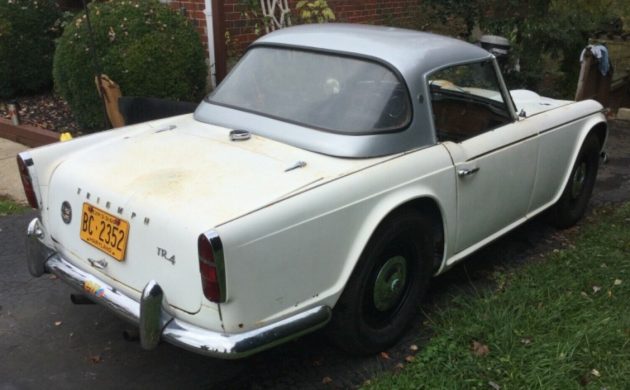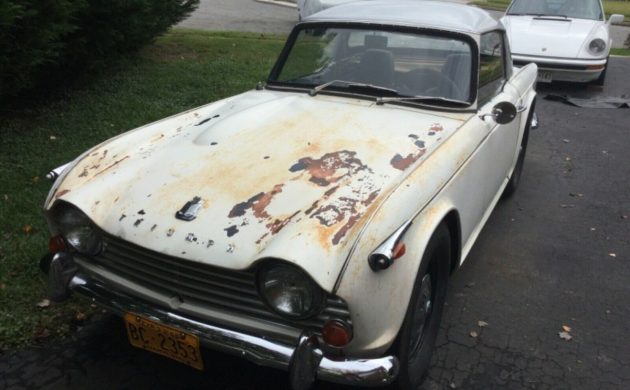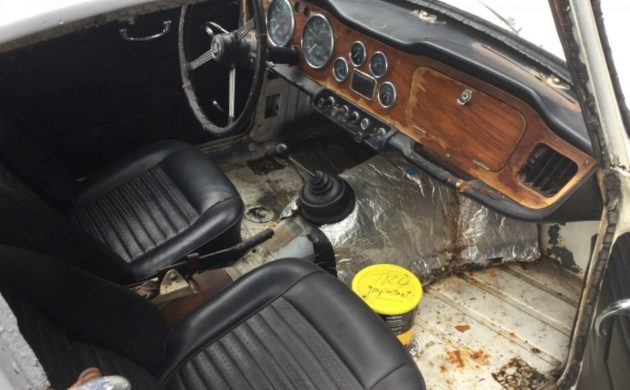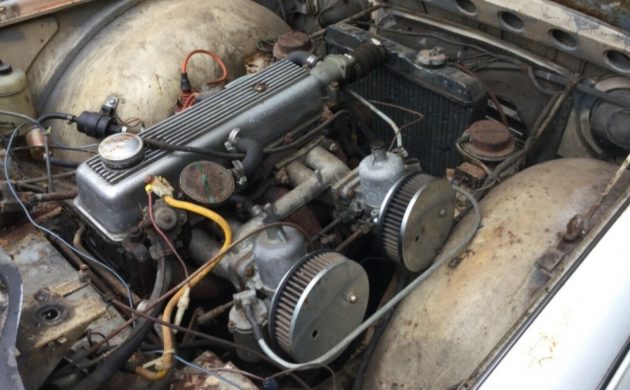Recently, I reviewed both Triumph TR3s and TR6s, so how about a TR4? This 1966 model’s creased lines and silver, removable hardtop caught my attention, so let’s check this one out in detail. It is located in Parkville (Baltimore), Maryland and is available, here on eBay for a current bid of $4,200, sixteen bids tendered so far.
In production between 1961 and 1965, the TR4 was the logical successor to the TR3A. One of the biggest differences, besides the angular rear design, which was penned by Italian designer Giovanni Michelotti, is the TR4’s addition of roll-up side windows in lieu of side curtains like those present on The TR3. The TR4 sold well, approximately 40K copies found owners in its five model year run.
This subject car has some obvious signs of surface rust on its top surfaces and the seller claims that new rocker panels with end caps have been installed so it sounds as if the corrosion problem was a bit more than the noted surface variety. The white finish is typically flat but the body panels are straight and appear to be rot-free and all of the trim is in place – always good to discover. The most obvious visual is the Parrish removable hardtop. Unlike some removable lids, this one looks like it actually belongs. The seller mentions that he has the convertible top frame and a tonneau cover and it is included in the sale. At this point, the exterior of this TR4 looks like it could use a cosmetic refresh but appears to be sound otherwise.
The interior has had the carpet and underlay removed with a new heat resistant underlay added across the transmission tunnel. The black vinyl seat upholstery looks great and the floors show as being sound. The wood veneer instrument panel is starting to delaminate but it can probably be refinished. Fortunately, all of the instruments look to be present but there is no mention of their operability. The “loop” style dash pad is starting to disintegrate along the lower edge, beneath the instrument panel; you can see where the grab handle has given it up. The door cards look good, however. Of note, the weatherstripping has dissolved but there are numerous parts that go with the car, perhaps new ones are included.
This TR4 is a driver, though its only operational accolade is, “Motor Runs.” Not exactly a ringing endorsement but better than the usual, “I have not tried to start engine” which is frequently the quoted tagline. Standard power is a 105 HP, 2.1 liter, in-line, four-cylinder engine working in concert with a four-speed manual transmission. The mileage is listed as 54K miles; whether that is an actual measurement or not is unknown.
My initial thought here is that this Triumph is a pretty sound base from which to work. While the motor is stated as “running” so we’ll go with the assumption that this TR4 is a driver and can be used and enjoyed while additional improvements commence. What do you think, a potentially good acquisition or too many possible pitfalls?










I think seller is supplying the parts mentioned. Last couple pictures are the mentioned parts. Could still turn out to be a buy.
Not only that, it comes with a coffee can marked “TR-4 important” so you know you’ve gotten the motherlode of important spares.
That’s a TR4A – not a TR4. TR4s were made up to about 1964. The front grille and the lights on the outside edge of the front fenders are TR4A features ( there are a lot of other small details by which you can tell them apart…HS6 carbs instead of H6, etc.. but the grille and the side lights most obvious). It is odd that it has a TR4 badge on the trunk…
The deciding factor will likely be the rear axle. If it’s a solid axle or the IRS suspension found in the TR4A.
I don’t live very far from this car, so if someone is serious about buying it, know that I ran a large TR repair & restoration shop in Maryland in the late 1970s, and I’m willing to check it out, just let me know here.
I had a 66 TR4A with the solid axle, and I believe that it just had TR4 on the boot lid. If it had had the independent rear suspension, it would have had TR4irs
New rear deck at some point last 56 years?
The rust on TR for Can be deceiving. The rear fenders are bolted on with a chrome strip hiding the separation. 4’s rust there and you can never see it until it becomes a paramount issue. And don’t have any good pictures of the rocker panels.
Another issue as my 4 had holes in the transmission cover so I think so heat shielding is hiding a transmission housing that needs to be replaced.
As to not running they were prone to have electrical glitches that are easy to fix if you can find them.Also the timing can be a bear,Sinkingcarbs can test your faith in God.
But on the bright side they are easy to work on the engines are last forever easy to rebuild.
They are a hoot to drive. I had a great time when I had a mine.
Factory trans covers were pressed cardboard [!], and within 10 years in wet climates, they often fell apart. Moss Motors began offering fiberglass replacements in the mid 1970s, and most TR cars today have these installed. That said, the fiberglass covers DO need a heat shield covering under the carpet overlay.
Ok my 4had holes in the cardboard cover had to sell it before I had it fixed. So I have a question, why the heat shield?
Steve Blum,
While the original pressed cardboard isn’t a great insulator, it’s far better than solid fiberglass & resin material that simply passes the heat into the interior of the car, like a metal cover would. I have vivid memories of resting my thigh against a TR3A’s fiberglass trans cover and I quickly “felt the burn”.
But there’s more than just heat involved, the rigid fiberglass tends to pass sounds as well as heat. So just as we often insulate the floors & firewalls to deaden sound & heat transfer, we do so to the trans covers as well.
I had a ’62’ back in the day after I got out of the service in 69, and I never had my foot anywhere but in the grille beating the holy hell out of it – – and every day it came back and ran and took more punishment.
I have a ’64’ in the garage now that I am working on, and going to keep – and sell my ’69’ TR6. I miss the solid axle driving thrills of my TR4, and that’s why I’m keeping it.